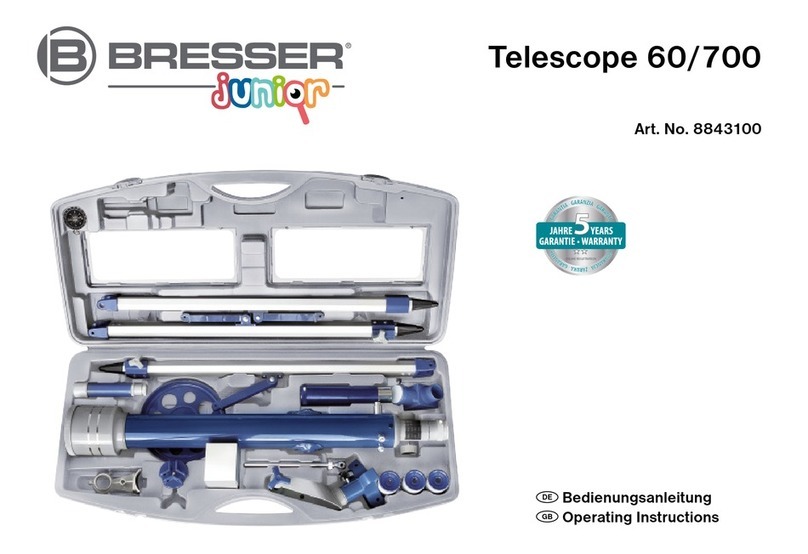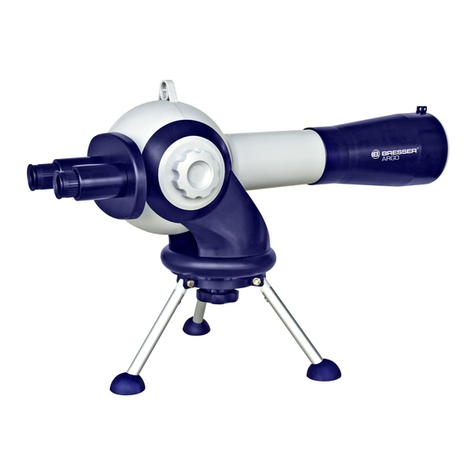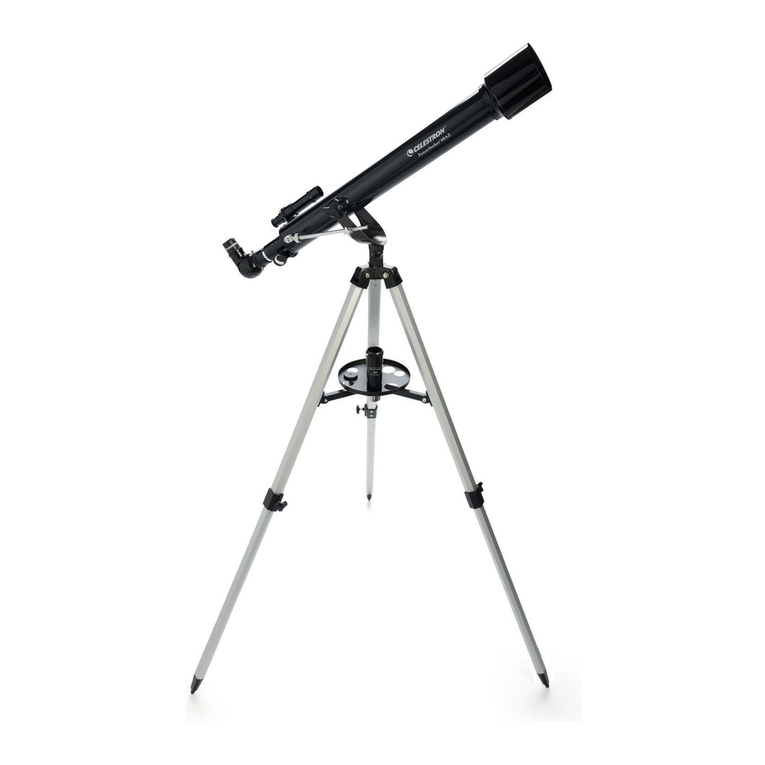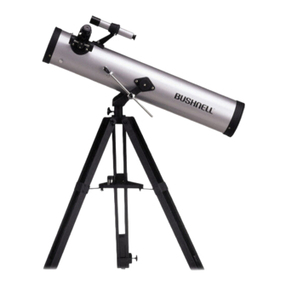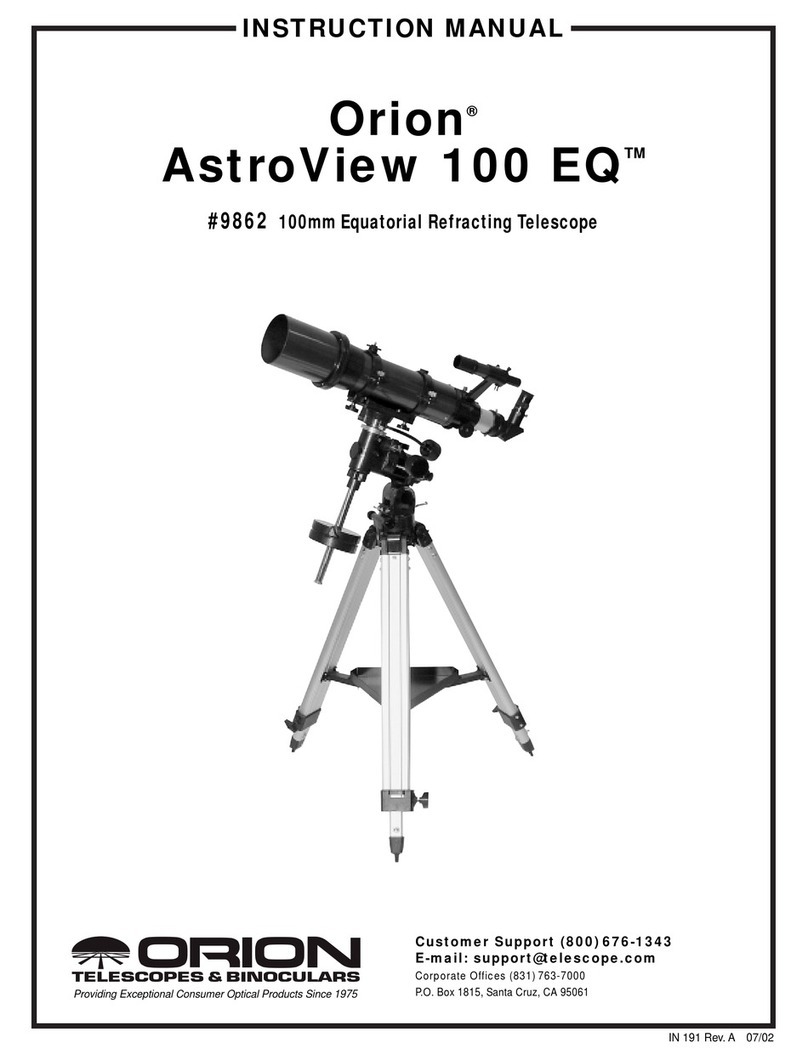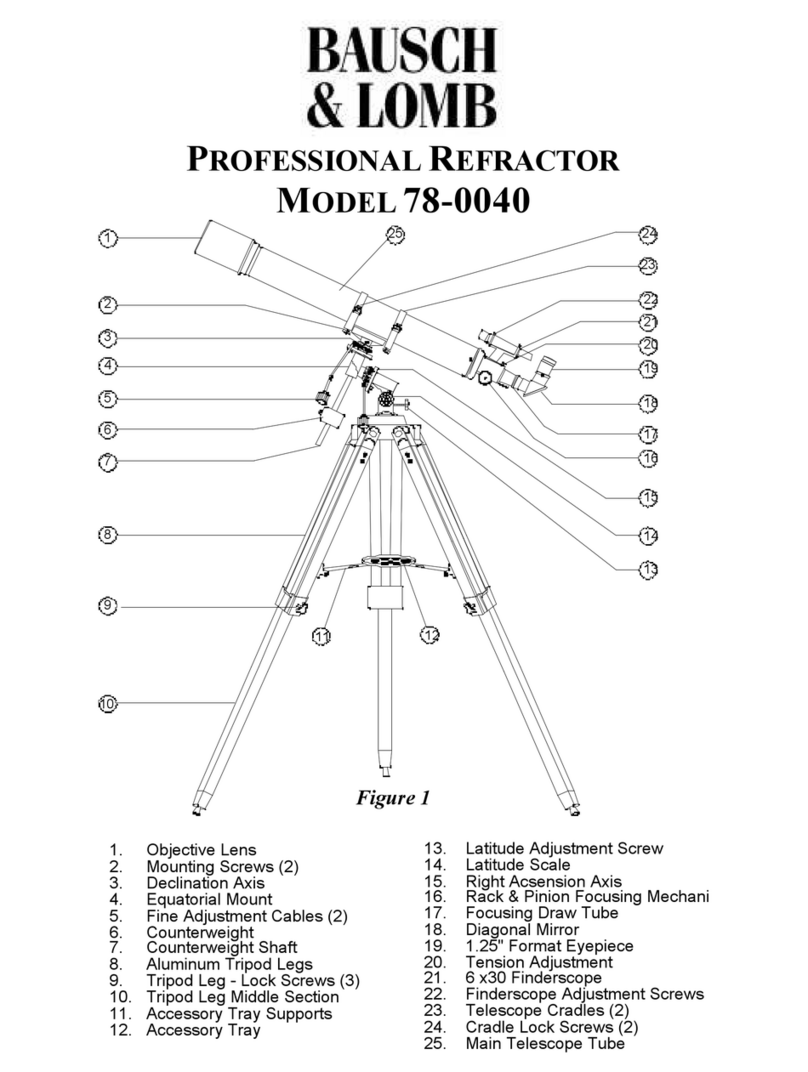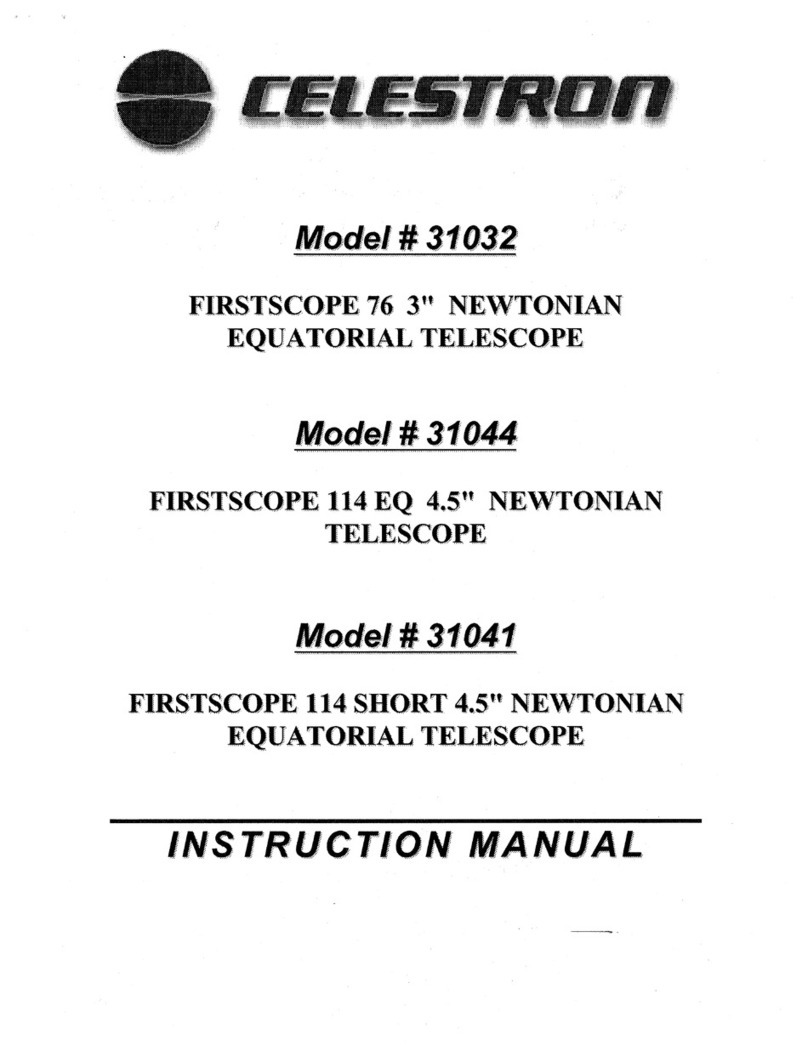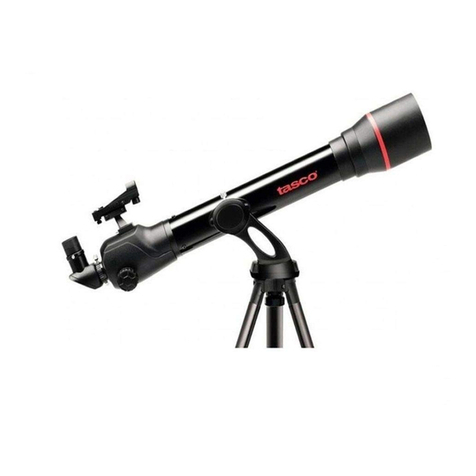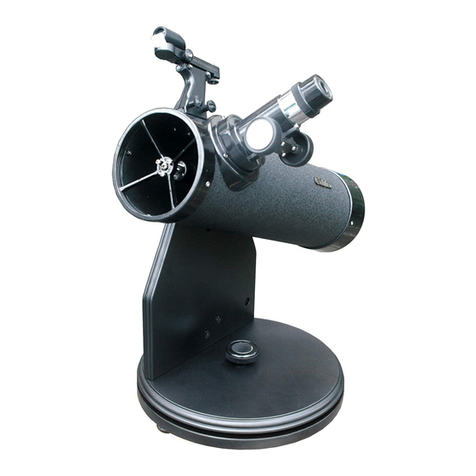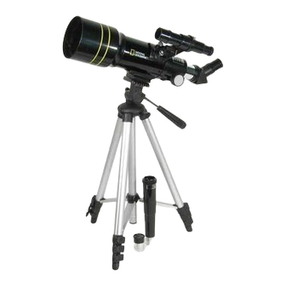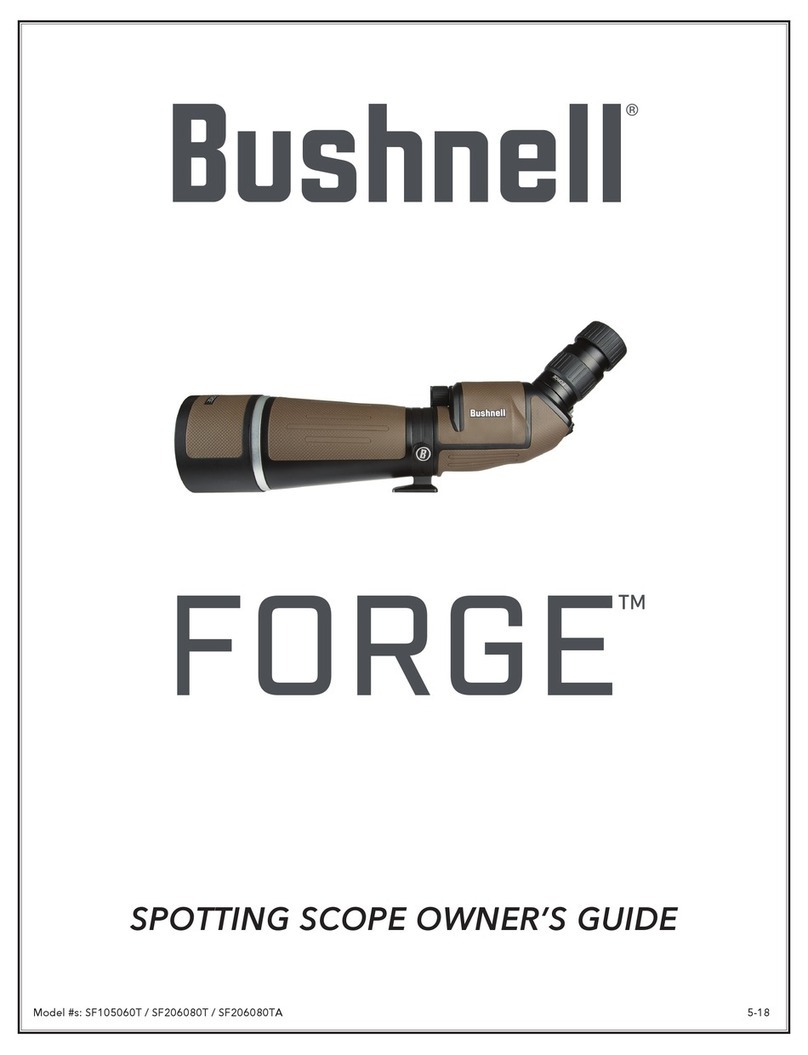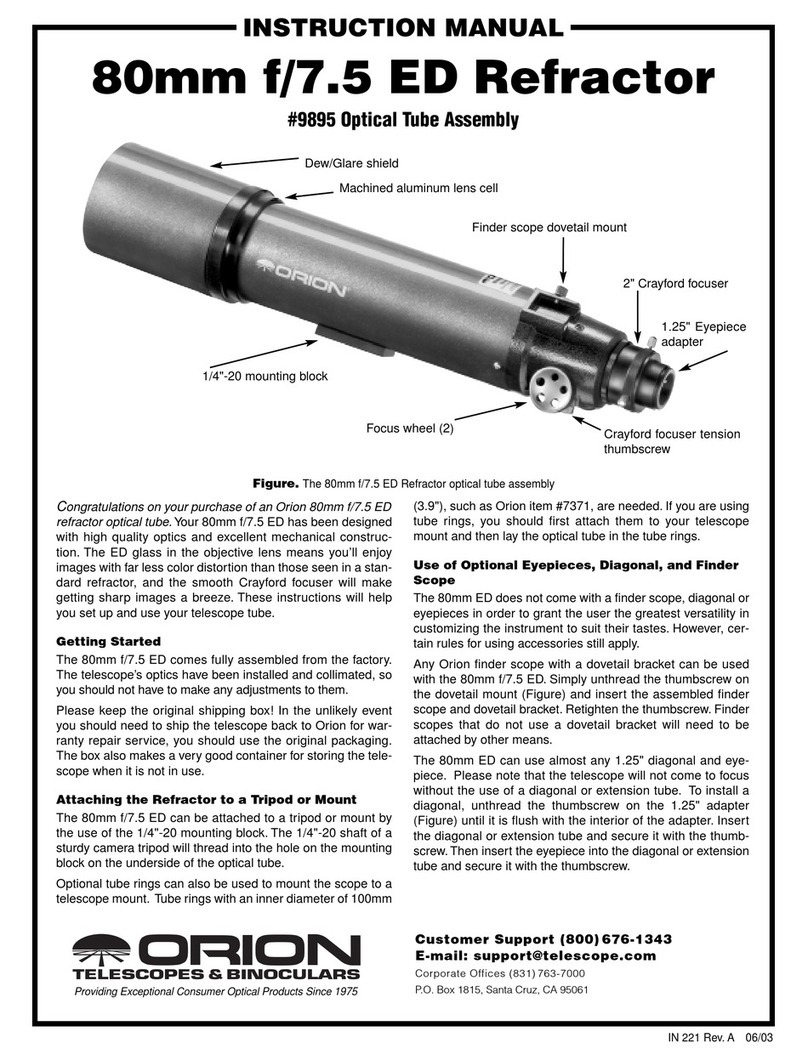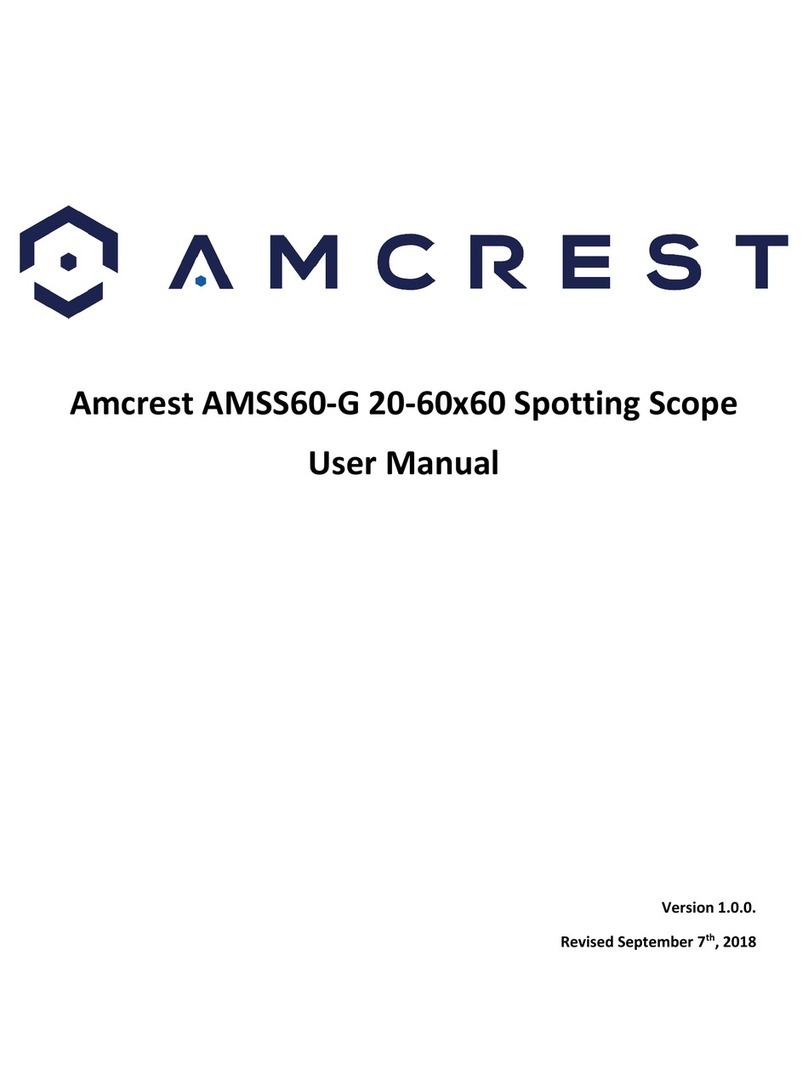Bresser Junior 60/700 User manual

Art. No. 8843100
Teleskop/Telescope
60/700
DE Bedienungsanleitung
EN Operating Instructions
FR Mode d’emploi
NL Handleiding
IT Istruzioni per l’uso
ES Instrucciones de uso
PT Manual de utilização

www.bresser.de/warranty_terms
SERVICE AND WARRANTY:
www.bresser.de/guide
TELESCOPE GUIDE:
i
www.bresser.de/faq
TELESCOPE FAQ:
www.bresser.de/downloads
DOWNLOADS:
www.bresser.de/P8843100
MANUAL DOWNLOAD:
(DE) WARNUNG:
Schauen Sie mit diesem Gerät niemals
direkt in die Sonne oder in die Nähe der
Sonne. Es besteht ERBLINDUNGSGEFAHR!
(EN) WARNING:
Never use this device to look directly at the
sun or in the direct proximity of the sun.
Doing so may result in a risk of blindness.
DE Bedienungsanleitung................................................................4
EN Operating Instructions............................................................ 12
FR Mode d’emploi....................................................................... 20
NL Handleiding .......................................................................... 28
IT Istruzioni per l’uso................................................................. 36
ES Instrucciones de uso .............................................................. 44
PT Manual de utilização .............................................................. 52

i
B
d
e
F
GH
1!
1(1#
1$
1^
1&
1%
j
1)
c
1*
1@
2!
2@
2)
E
F

4
GEFAHR für Ihr Kind!
Schauen Sie mit diesem Gerät niemals
direkt in die Sonne oder in die Nähe der
Sonne. Es besteht ERBLINDUNGSGEFAHR!
Kinder sollten das Gerät nur unter Aufsicht be-
nutzen. Verpackungsmaterialien (Plastiktüten,
Gummibänder, etc.) von Kindern fernhalten! Es
besteht ERSTICKUNGSGEFAHR!
BRANDGEFAHR!
Setzen Sie das Gerät – speziell die Lin-
sen – keiner direkten Sonneneinstrah-
lung aus! Durch die Lichtbündelung könnten
Brände verursacht werden.
GEFAHR von Sachschäden!
Bauen Sie das Gerät nicht auseinander!
Wenden Sie sich im Falle eines Defekts
bitte an Ihren Fachhändler. Er nimmt mit dem
Service-Center Kontakt auf und kann das Gerät
ggf. zwecks Reparatur einschicken.
Setzen Sie das Gerät keinen Temperaturen über
60° C aus!
HINWEISE zur Reinigung
Reinigen Sie die Linsen (Okulare und/
oder Objektive) nur mit dem beiliege-
den Linsenputztuch oder mit einem
anderen weichen und fusselfreien
Tuch (z.B. Microfaser) ab. Das Tuch nicht zu
stark aufdrücken, um ein Verkratzen der Linsen
zu vermeiden.
Zur Entfernung stärkerer Schmutzreste be-
feuchten Sie das Putztuch mit einer Brillen-
Reinigungsüssigkeit und wischen Sie damit
die Linsen mit wenig Druck ab.
Schützen Sie das Gerät vor Staub und Feuchtig-
keit! Lassen Sie es nach der Benutzung – spe-
ziell bei hoher Luftfeuchtigkeit – bei Zimmer-
temperatur einige Zeit akklimatisieren, so dass
die Restfeuchtigkeit abgebaut werden kann.
Setzen Sie die Staubschutzkappen auf und be-
wahren Sie es in der mitgelieferten Tasche auf.
SCHUTZ der Privatsphäre!
Das Teleskop ist für den Privat-
gebrauch gedacht. Achten Sie die
Privatsphäre Ihrer Mitmenschen –
schauen Sie mit diesem Gerät zum Beispiel
nicht in Wohnungen!
ENTSORGUNG
Entsorgen Sie die Verpackungsmateri-
alien sortenrein. Informationen zur ord-
nungsgemäßen Entsorgung erhalten Sie
beim kommunalen Entsorgungsdienstleister
oder Umweltamt.

5
DE
Aus diesen Teilen besteht dein Teleskop
1 Höhenfeineinstellung
2 Fokussiertrieb
3 Fokussierrohr
4 Zenitspiegel
5 Okulare
6 Sucherfernrohr-Halterung
7 Sucherfernrohr
8 Fernrohr (Teleskop-Tubus)
9 Sonnenblende
10 Objektivlinse
11 Feststellschraube
12 Schraube zur Höheneinstellung
13 Joch
14 Azimut-Sicherung
15 Stativkopf
16 Zubehörablage
17 Stativbein
18 Flügelschraube
19 Schraube
20 Okularverlängerung
21 Kompass
22 Mondlter
Befestige die Stativbeine mit Hilfe der Flügel-
schrauben, Unterlegscheiben und Flügelmut-
tern am Stativkopf.
Bringe die Mittelstrebe mit den kleinen Schrau-
ben an den Stativbein-Streben an.
– Wichtig! Der goldene Kreis der Mittelstrebe
muss nach oben zeigen.
Schraube zum
Schluss den
Zubehörteller
auf der Mittel-
strebe fest.
Der Aufbau
Du beginnst mit dem Aufbau des Stativs und
benötigst dazu folgende Teile:
Stativbeine u. Streben
Mittelstrebe
Stativkopf
Zubehörteller
Flügelschrauben
Flügelmuttern
Kleine Schrauben
Unterlegscheiben
Schraubwerkzeug
b
c
d

6
Jetzt wendest Du Dich dem Teleskop-Tubus zu
und ndest noch folgende Teile vor:
Teleskop-Tubus
Sucherfernrohr
Sucherfernrohr-Halterung
Höhenfeineinstellung u. Schrauben
Zenitspiegel
Okularverlängerung
Okulare
Wendelschrauben u. Unterlegscheiben
Zuerst musst Du das Sucherfernrohr mit der
Sucherfernrohr-Halterung verbinden (einsetzen
und mit drei Schräubchen festdrehen).
Am Teleskop-Tubus erkennst Du zwei heraus-
ragende Gewinde. Dort schraubst Du die Halte-
rung mit dem Sucherfernrohr fest.
Als Nächstes schraubst Du die Höhenfeinein-
stellung an dem herausragenden silbernen Me-
tallstutzen des Teleskop-Tubus an.
Nun wird es schwierig! Am besten lässt Du Dir
von jemandem helfen. Du musst den Teleskop-
Tubus mit dem Stativ verbinden. Nimm dazu die
Wendelschrauben mit den Unterlegscheiben
und schraube den Tubus am Stativkopf an.
b
c
d
E

7
DE
Azimutale Montierung
Azimutale Montierung bedeutet nichts anderes,
als dass Du Dein Teleskop auf- und abwärts
und nach links und rechts bewegen kannst,
ohne das Stativ zu verstellen.
Mit Hilfe der Azimut-Sicherung und der Schrau-
ben für die Höhenfeineinstellung kannst Du
Dein Teleskop feststellen, um ein Objekt zu -
xieren (d. h. fest anzublicken).
Mit Hilfe der Höhenfeineinstellung bewegst Du
das Teleskop langsam auf- und abwärts.
Und nach Lösen der Azimut-Sicherung kannst
Du es nach links und nach rechts schwenken.
Höhenfeinein-
stellung
Azimut-Sicherung
Bringe die Feststellschraube für die Höhenfein-
einstellung am Joch des Stativkopfes an.
Montiere jetzt den Zenitspiegel am Fokussier-
rohr des Tubus.
Wenn Du die Okularverlängerung nutzen möch-
test, befestige sie am Zenitspiegel.
Als Letztes wählst Du eines der drei Okulare
und befestigst es am Zenitspiegel (oder an der
Okularverlängerung).
F
G
H
I
1)
j

8
Vor der ersten Beobachtung
Bevor du zum ersten Mal etwas beobachtest,
musst du das Sucherfernrohr und das Fernrohr
aufeinander abstimmen. Du musst das Sucher-
fernrohr so einstellen, dass du dadurch das
gleiche siehst wie durch das Okular des Fern-
rohrs. Nur so kannst du bei deinen Beobachtun-
gen das Sucherfernrohr zum groben Anpeilen
von Objekten benutzen, bevor du sie vergrößert
durch das Fernrohr-Okular betrachtest.
Sucherfernrohr und das Fernrohr aufeinander
abstimmen
Schaue durch das Okular des Fernrohrs und
peile ein gut sichtbares Objekt (z.B. einen
Kirchturm) in einiger Entfernung an. Stelle es
mit dem Scharfeinstellungsrad scharf wie es in
Abb. 11 gezeigt wird.
Wichtig: Das Objekt muss mittig im Blickfeld
des Okulars zu sehen sein.
Tipp: Löse die Fixierschrauben für die Höhen-
feineinstellung und die Vertikalachse, um das
Fernrohr nach rechts und links oder nach oben
und unten bewegen zu können. Wenn du das
Objekt richtig im Blickfeld hast, kannst du die
Fixierschrauben wieder anziehen, um die Posi-
tion des Fernrohrs zu xieren.
Als nächstes schaust du durch das Sucherfern-
rohr. Du siehst das Bild deines angepeilten Ob-
jekts in einem Fadenkreuz. Das Bild steht auf
dem Kopf.
Hinweis: Das Bild, das du durch das Sucherfern-
rohr siehst, steht auf dem Kopf, weil das Bild
durch die Optik umgekehrt wird. Das ist völlig
normal und kein Fehler.
Falls das Bild, das du durch das Sucherfernrohr
siehst, nicht genau mittig im Fadenkreuz steht
(Abb. 12a), musst du an den Justierschrauben
für das Sucherfernrohr drehen. Drehe solange
an den Schrauben, bis das Bild mittig im Faden-
kreuz steht (Abb. 12b).
Du solltest nun beim Blick durch das Okular den
gleichen Bildausschnitt wie beim Blick durch
das Sucherfernrohr (aber natürlich auf dem
Kopf stehend) sehen.
Wichtig: Erst wenn beide Bildausschnitte gleich
sind, sind Sucherfernrohr und Fernrohr richtig
aufeinander abgestimmt.
1!
1@ b
a

9
DE
Verwendung des Mondlters
Wenn dir das Bild des Mondes irgendwann zu
hell ist, dann kannst du den grünen Mondlter
von unten in das Gewinde des Okulars ein-
schrauben. Das Okular kannst du dann ganz
normal in den Zenitspiegel einsetzen.
Das Bild das du nun beim Blick durch das Oku-
lar siehst, ist grünlich. Die Helligkeit des Mon-
des wird dadurch verringert, das Beobachten ist
angenehmer.
Welches ist das richtige Okular?
Wichtig ist zunächst, dass du für den Beginn deiner Beobachtungen immer ein Okular mit der höchs-
ten Brennweite wählst. Du kannst dann nach und nach andere Okulare mit geringerer Brennweite
wählen. Die Brennweite wird in Millimeter angegeben und steht auf dem jeweiligen Okular. Generell
gilt: Je größer die Brennweite des Okulars, desto niedriger ist die Vergrößerung! Für die Berechnung
der Vergrößerung gibt es eine einfache Rechenformel:
Brennweite des Fernrohrs : Brennweite des Okulars = Vergrößerung
Du siehst: Die Vergrößerung ist auch von der Brennweite des Fernrohrs abhängig. Dieses Teleskop
beinhaltet ein Fernrohr mit 700 mm Brennweite. Daraus ergibt sich anhand der Rechenformel fol-
gende Vergrößerung, wenn du ein Okular mit 20 mm Brennweite verwendest:
700 mm : 20 mm = 35fache Vergrößerung
Zur Vereinfachung habe ich dir hier eine Tabelle mit einigen Vergrößerungen
zusammengestellt:
Teleskop-Brennweite Okular-Brennweite Vergrößerung mit 1,5x Umkehrlinse
700 mm 24 mm 29x 43,5x
700 mm 20 mm 35x 52,5x
700 mm 12,5 mm 56x 84x
700 mm 6 mm 116x 174x
700 mm 4 mm 175x 262,5x
F
2@
1%
E

10 10
Technische Daten:
• Bauart: achromatischer Refraktor
• Brennweite: 700 mm
• Objektivdurchmesser: 60 mm
• Sucher: 5x24
• Montierung: azimutal auf Stativ
Mögliche Beobachtungsobjekte:
Nachfolgend haben wir für dich einige sehr
interessante Himmelskörper und Sternhaufen
ausgesucht und erklärt. Auf den zugehörigen
Abbildungen am Ende der Anleitung kannst du
sehen, wie du die Objekte durch dein Teleskop
mit den mitgelieferten Okularen bei guten Sicht-
verhältnissen sehen wirst:
Der Mond
Der Mond ist der einzige natürliche Satellit der
Erde. (Abb. 13)
Durchmesser: 3.476 km
Entfernung: ca. 384.401 km
Der Mond ist seit prähistorischer Zeit bekannt.
Er ist nach der Sonne das zweithellste Objekt
am Himmel. Da der Mond einmal im Monat
um die Erde kreist, verändert sich ständig der
Winkel zwischen der Erde, dem Mond und der
Sonne; man sieht das an den Zyklen der Mond-
phasen. Die Zeit zwischen zwei aufeinander
folgenden Neumondphasen beträgt etwa 29,5
Tage (709 Stunden).
1#
f=20 mm f=12 mm f=4 mm
Der Mond
Orion-Nebel (M 42)
Ringnebel in
der Leier (M 57)
Hantel-Nebel
im Füchslein (M 27)
1$
1%
1^

11
DE
Orion-Nebel (M 42)
M 42 im Sternbild Orion (Abb. 14)
Rektaszension: 05:32,9 (Stunden : Minuten)
Deklination: –05:25 (Grad : Bogenminuten)
Entfernung: 1.500 Lichtjahre
Mit einer Entfernung von etwa 1500 Lichtjahren
ist der Orion-Nebel (Messier 42, kurz M 42) der
hellste diffuse Nebel am Himmel – mit dem blo-
ßen Auge sichtbar, und ein lohnendes Objekt für
Teleskope in allen Größen, vom kleinsten Feld-
stecher bis zu den größten erdgebundenen Ob-
servatorien und dem Hubble Space Telescope.
Es handelt sich um den Hauptteil einer weit grö-
ßeren Wolke aus Wasserstoffgas und Staub, die
sich mit über 10 Grad gut über die Hälfte des
Sternbildes Orion erstreckt. Die Ausdehnung
dieser gewaltigen Wolke beträgt mehrere hun-
dert Lichtjahre.
Ringnebel in der Leier (M 57)
M 57 im Sternbild Leier (Abb. 15)
Rektaszension: 18:51,7 (Stunden : Minuten)
Deklination: +32:58 (Grad : Bogenminuten)
Entfernung: 2.000 Lichtjahre
Der berühmte Ringnebel M 57 im Sternbild Leier
wird oft als der Prototyp eines planetarischen
Nebels angesehen; er gehört zu den Prachtstü-
cken des Sommerhimmels der Nordhalbkugel.
Neuere Untersuchungen haben gezeigt, dass
es sich aller Wahrscheinlichkeit nach um einen
Ring (Torus) aus hell leuchtender Materie han-
delt, die den Zentralstern umgibt (nur mit grö-
ßeren Teleskopen sichtbar), und nicht um eine
kugel- oder ellipsoidförmige Gasstruktur.
Würde man den Ringnebel von der Seitenebene
betrachten, würde er dem Hantel-Nebel (M 27)
ähneln. Wir blicken bei diesem Objekt genau
auf den Pol des Nebels.
Hantel-Nebel im Füchslein (M 27)
M 27 im Sternbild Füchslein (Abb. 16)
Rektaszension: 19:59,6 (Stunden : Minuten)
Deklination: +22:43 (Grad : Bogenminuten)
Entfernung: 1.250 Lichtjahre
Der Hantel-Nebel (M 27) im Füchslein war der
erste planetarische Nebel, der überhaupt ent-
deckt worden ist. Am 12. Juli 1764 entdeckte
Charles Messier diese neue und faszinieren-
de Klasse von Objekten. Wir sehen dieses
Objekt fast genau von seiner Äquatorialebe-
ne. Würde man den Hantel-Nebel von einem
der Pole sehen, würde er wahrscheinlich die
Form eines Ringes aufweisen und dem An-
blick ähneln, den wir von dem Ringnebel M 57
kennen. Dieses Objekt kann man bereits bei
halbwegs guten Wetterbedingungen bei kleinen
Vergrößerungen gut sehen.
EG-Konformitätserklärung
Eine „Konformitätserklärung“ in
Übereinstimmung mit den anwend-
baren Richtlinien und entsprechen-
den Normen ist von der Bresser GmbH erstellt
worden. Der vollständige Text der EG-Konformi-
tätserklärung ist unter der folgenden Internet-
adresse verfügbar:
www.bresser.de/download/8843100/
CE/8843100_CE.pdf
Garantie & Service
Die reguläre Garantiezeit beträgt 5 Jahre und
beginnt am Tag des Kaufs. Die vollständigen
Garantiebedingungen und Serviceleistungen
können Sie unter www.bresser.de/garantiebe-
dingungen einsehen.

12
RISK to your child!
Never look through this device directly
at or near the sun. There is a risk of BL-
INDING YOURSELF!
Children should only use this device under su-
pervision. Keep packaging materials (plastic
bags, rubber bands, etc.) away from children.
There is a risk of SUFFOCATION!
Fire/Burning RISK!
Never subject the device - especially the
lenses - to direct sunlight. Light ray con-
centration can cause res and/or burns.
RISK of material damage!
Never take the device apart. Please con-
sult your dealer if there are any defects.
The dealer will contact our service centre and
send the device in for repair if needed.
Do not subject the device to temperatures ex-
ceeding 60 C.
TIPS on cleaning
Clean the lens (objective and eyepi-
ece) only with the cloth supplied or
some other soft lint-free cloth (e.g.
micro-bre). Do not use excessive pressure -
this may scratch the lens.
Dampen the cleaning cloth with a spectacle
cleaning uid and use it on very dirty lenses.
Protect the device against dirt and dust. Leave
it to dry properly after use at room temperature.
Then put the dust caps on and store the device
in the case provided.
RESPECT privacy!
This device is meant for private use.
Respect others‘ privacy – do not use
the device to look into other people‘s
homes, for example.
DISPOSAL
Dispose of the packaging material/s as
legally required. Consult the local autho-
rity on the matter if necessary.

Your telescope consists of these parts:
1 Vertical ne adjustment
2 Focus wheel
3 Focus tube
4 Zenith mirror
5 Eyepiece
6 Finderscope holder
7 Finderscope
8 Telescope (Telescope tube)
9 Lens hood
10 Objective lens
11 Locking screw
12 Screw for the vertical ne
adjustment mechanism
13 Yoke
14 Azimuth Safety
15 Tripod head
16 Accessories caddy
17 Tripod leg
18 Wing screw
19 Screw
20 Eyepiece extender
21 Compass
22 Moon lter
Fix the tripod to the tripod head with the help of
the wing screw, washers and wing nuts.
Attach the middle span to the tripod spans with
the small screws. - Important! The golden circle
on the middle span must be pointing upwards.
Finally, screw
the accessory
plate onto the
middle span.
Assembly
First, you assemble the tripod. For this, you‘ll
need the following parts:
Tripod leg and spans
Division bar
Tripod head
Accessories plate
Wing screw
Wing nuts
Small screws
Washers
Assembly tools for
screws and nuts
EN
13
b
c
d

14
Now, you turn to the telescope tube
and nd the following pieces:
Telescope tube
Finderscope
Finderscope holder
Vertical adjustment
zenith mirror
eyepiece extenders and screws
Eyepieces
Spiral screws and Washers
First, you need to x connect the nderscope to
the nderscope holder (insert and tighten with
three screws).
You will notice three threads protruding from
the telescope tube. Here, you can attach the
holder with the nderscope.
Next, screw the vertical ne adjustment to the
protruding silver metal supports on the tele-
scope tube.
Now it’s going to get difcult! It is best if you
let someone help you. You need to attach the
telescope tube to the tripod. To do so, take the
spiral screw with the washers and screw the
tube to the tripod head.
b
c
d
E

Azimuthal mounting
Azimuthal mounting just means
that you can move your telescope up and down,
left and right, without having to adjust the tri-
pod.
With the help of the azimuth safety and the
screws for the vertical ne adjustment, you can
lock your telescope in order to x on an object
(have this object right in your eld of vision).
With the help of the vertical ne adjustment,
you can move the telescope slowly up and
down. And after you release the azimuth safety,
you can move it right and left.
Vertical ne
adjustment
Azimuth Safety
Attach the locking screw for the vertical ne
adjustment to the tripod head yoke.
Now, mount the zenith mirror on to the focus
tube.
If you want to use the eyepiece extender, attach
it to the zenith mirror.
Finally, select one of the three eyepieces and
x it to the zenith mirror (or on the eyepiece
extender).
F
G
H
I
1)
j
EN
15

16
Before looking through your telescope for the
rst time
Before you look at something for the rst time,
you must coordinate the nderscope and the
telescope lens. You have to position the n-
derscope in such a way that you see the same
thing through it as you do through the eyepiece
of the telescope. This is the only way you can
use your nderscope to hone in roughly on ob-
jects before you observe these objects magni-
ed through the telescope eyepiece.
Coordinating the nderscope and the
telescope
Look through the telescope eyepiece and hone
in on a far away object that you can see well
(for instance, a church tower). Focus in on the
object with the focus knob in the way shown in
gure 11.
Important: The object must be located in the
middle of your eld of vision when you look
through the telescope eyepiece.
Tip: If you loosen the locating screws for the
vertical ne adjustment and the vertical axis,
you will be able to move the telescope to the
right and left, up and down. When you have the
object well placed in your eld of vision, you
can retighten the locating screws and x the
position of the telescope.
Look through the telescope eyepiece and hone
in on a far away object that you can see well
(for instance, a church tower). Focus in on the
object with the focus knob in the way shown in
gure 11.
Important: The object must be located in the
middle of your eld of vision when you look
through the telescope eyepiece.
Tip: If you loosen the locating screws for the
vertical ne adjustment and the vertical axis,
you will be able to move the telescope to the
right and left, up and down. When you have the
object well placed in your eld of vision, you
can retighten the locating screws and x the
position of the telescope.
Next, look through the nderscope. You will see
the image of the object you honed in on in the
crosshairs. The image will be upside down.
Note: The image you see through the nder-
scope is upside down because the lenses are
inverting it. This is completely normal, and not
an error.
1!
1@ b
a

EN
17
Use of the moon lter
If the image of the moon is too bright for you,
you can screw the green moon lter into the
bottom of the thread of the eyepiece. Then you
can set the eyepiece normally into the zenith
mirror.
The image that you see by looking through the
eyepiece is now greenish. The moon appears
less bright, and so observation is more ple-
asant.
Which eyepiece is right?
First of all, it is important that you always choose an eyepiece with the highest focal width for the
beginning of your observation. Afterwards, you can gradually move to eyepieces with smaller focal
widths. The focal width is indicated in millimeters, and is written on each eyepiece. In general, the
following is true: The larger the focal width of an eyepiece, the smaller the magnication! There is
a simple formula for calculating the magnication:
Focal width of the telescope tube : Focal width of the eyepiece = magnication
You see: The magnication is also depends on the focal width of the telescope tube. This telescope
contains a telescope tube with focal width of 700 mm. From this formula, we see that if you use an
eyepiece with a focal width of 20 mm, you will get the following magnication:
700 mm / 20 mm = 35 x magnication
To make things simpler, I’ve put together a table with some magnications:
Telescope tube
focal width
Focal width of
eyepiece
Magnication with 1.5x inverting lens
700 mm 24 mm 29x 43,5x
700 mm 20 mm 35x 52,5x
700 mm 12,5 mm 56x 84x
700 mm 6 mm 116x 174x
700 mm 4 mm 175x 262,5x
F
2@
1%
E

18
Technical data:
• Design: achromatic refractor
• Focal width: 700 mm
• Objective lens diameter: 60 mm
• Viewfinder: 5x24
• Mounting: azimuthal with tripod
Possible objects for observation:
We have compiled and explained a number
of very interesting celestial bodies and star
clusters for you. On the accompanying images
at the end of the instruction manual, you can
see how objects will appear in good viewing
conditions through your telescope using the
eyepieces that came with it.
The Moon
The moon is the Earth’s only natural satellite.
Figure 13)
Diameter: 3.476 km
Distance: approx. 384 401 km
The moon has been known to humans since
prehistoric times. It is the second brightest
object in the sky (after the sun). Because the
moon circles the Earth once per month, the
angle between the Earth, the moon and the sun
is constantly changing; one sees this change in
the phases of the moon. The time between two
consecutive new moon phases is about 29.5
days (709 hours).
1%
1^
1$
1#
f=20 mm f=12 mm f=4 mm
The Moon
Orion Nebula (M 42)
Ring Nebula in
Lyra constellation (M 57)
Dumbbell Nebula in
the Vulpecula (Fox)
constellation (M 27)

EN
19
Orion Nebula (M 42)
M 42 in the Orion constellation (Figure 14)
Right ascension: 05:32.9 (Hours: Minutes)
Declination: -05:25 (Degrees: Minutes)
Distance: 1.500 light years
With a distance of about 1500 light years, the
Orion Nebula (Messier 42, abbreviation: M 42) is
the brightest diffuse nebula in the sky – visible
with the naked eye, and a rewarding object for
telescopes in all sizes, from the smallest field
glass to the largest earthbound observatories
and the Hubble Space Telescope.
When talking about Orion, we‘re actually
referring to the main part of a much larger cloud
of hydrogen gas and dust, which spreads out
with over 10 degrees over the half of the Orion
constellation. The expanse of this enormous
cloud stretches several hundred light years.
Ring Nebula in Lyra constellation (M 57)
M 57 in the Lyra constellation (Figure 15)
Right ascension: 18:51.7 (Hours: Minutes)
Declination: -+32:58 (Degrees: Minutes)
Distance: 2.000 light years
The famous Ring Nebula M 57 in the
constellation of Lyra is often viewed as the
prototype of a planetary nebula; it is one of
the magnificent features of the Northern
Hemisphere’s summer sky. Recent studies
have shown that it is probably comprised of
a ring (torus) of brightly shining material that
surrounds the central star (only visible with
larger telescopes), and not of a gas structure in
the form of a sphere or an ellipsis.
If you were to look at the Ring Nebula from
the side, it would look like the Dumbbell
Nebula (M27). With this object, we’re looking
directly at the pole of the nebula.
Dumbbell Nebula in the Vulpecula (Fox)
constellation (M 27)
M 27 in the Fox constellation (Figure 16)
Right ascension: 19:59.6 (Hours: Minutes)
Declination: -+22:43 (Angle: Minutes)
Distance: 1.250 light years
The Dumbbell Nebula (M 27) in Fox was the
first planetary nebula ever discovered. On July
12, 1764, Charles Messier discovered this new
and fascinating class of objects. We see this
object almost directly from its equatorial plane.
If you could see the Dumbbell Nebula from one
of the poles, it would probably reveal the shape
of a ring, and we would see something very
similar to what we know from the Ring Nebula
(M 57). In reasonably good weather, we can see
this object well even with small magnifications.
EC Declaration of Conformity
Bresser GmbH has issued a
“Declaration of Conformity” in
accordance with applicable
guidelines and corresponding
standards. The full text of the EU declaration
of conformity is available at the following
internet address:
www.bresser.de/download/8843100/
CE/8843100_CE.pdf
UKCA Declaration of Conformity
Bresser GmbH has issued a „Declara-
tion of Conformity“ in accordance
with applicable guidelines and
corresponding standards. The full text of the
UKCA declaration of conformity is available at
the following internet address:
www.bresser.de/download/8843100/
UKCA/8843100_UKCA.pdf
Bresser UK Ltd. • Suite 3G, Eden House, Enterpri-
se Way, Edenbridge, Kent TN8 6HF, Great Britain
Warranty & Service
The regular guarantee period is 5 years and
begins on the day of purchase. You can consult
the full guarantee terms and details of our
services at www.bresser.de/warranty_terms.

20
DANGER pour votre enfant !
Avec cet appareil, ne regardez ja-
mais directement vers le soleil ou à
proximité du soleil. DANGER DE DEVENIR
AVEUGLE !
Les enfants ne devraient utiliser l’appareil que
soussurveillance. Gardezhorsde leurportée les
matériaux d’emballage (sachets en plastique,
élastiques etc.) ! DANGER D’ÉTOUFFEMENT !
DANGER D’INCENDIE!
Ne laissez jamais l’appareil – et surtout
les lentilles – exposé directement aux
rayons du soleil ! L’effet de loupe pourrait pro-
voquer des incendies.
DANGER de dommage sur le matériel !
Ne démontez jamais l’appareil! En cas
d’endommagement, adressez-vous à
votre revendeur. Il prendra contact avec le cen-
tre de service et pourra, le cas échéant, envoyer
l’appareil au service de réparations.
N’exposez jamais l’appareil à des températures
de plus de 60°C !
REMARQUES concernant le nettoyage
Pour nettoyer les lentilles (oculaires
et /ou objectifs), utilisez uniquement
le chiffon à lentilles ci-joint ou bien
un chiffon doux et non pelucheux (par exemple
en microbre). N’appuyez pas trop fortement le
chiffon sur les lentilles pour ne pas les rayer.
Pour retirer des traces de saleté plus résistan-
tes, humidiez légèrement le chiffon avec un
liquide prévu pour le nettoyage des lunettes et
passez sur les lentilles en exerçant une légère
pression.
Tenez l’appareil à l’abri de la poussière et de
l’humidité! Après l’avoir utilisé – spécialement
en cas de forte humidité dans l’air - laissez-
le quelque temps chez vous à température
ambiante an que le reste d’humidité puisse
s’évaporer. Placez les capuchons de protection
et conservez l’appareil dans la pochette incluse
à la livraison.
PROTECTION de la vie privée!
Les jumelles sont destinées à une uti-
lisation privée. Veillez à respecter la
vie privée des autres – par exemple,
ne regardez pas dans leurs habitations!
ÉLIMINATION
Éliminez les matériaux d’emballage selon
le type de produit. Pour plus
d’informations concernant l’élimination confor-
me, contactez le prestataire communal
d’élimination des déchets ou bien l’ofce de
l’environnement.
This manual suits for next models
1
Table of contents
Languages:
Other Bresser Junior Telescope manuals
